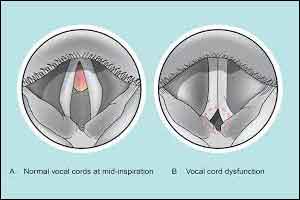- Home
- Editorial
- News
- Practice Guidelines
- Anesthesiology Guidelines
- Cancer Guidelines
- Cardiac Sciences Guidelines
- Critical Care Guidelines
- Dentistry Guidelines
- Dermatology Guidelines
- Diabetes and Endo Guidelines
- Diagnostics Guidelines
- ENT Guidelines
- Featured Practice Guidelines
- Gastroenterology Guidelines
- Geriatrics Guidelines
- Medicine Guidelines
- Nephrology Guidelines
- Neurosciences Guidelines
- Obs and Gynae Guidelines
- Ophthalmology Guidelines
- Orthopaedics Guidelines
- Paediatrics Guidelines
- Psychiatry Guidelines
- Pulmonology Guidelines
- Radiology Guidelines
- Surgery Guidelines
- Urology Guidelines
Study: New exercises help athletes manage dangerous breathing disorder

A novel set of breathing techniques developed by National Jewish Health help athletes overcome vocal cord dysfunction and improve performance during high-intensity exercise. Vocal cord dysfunction, now also referred to as exercise-induced laryngeal obstruction (EILO), has been shown to improve for athletes after being trained to use the new techniques. The findings were published in the September 16, 2017, online issue of the Journal of Voice.
"These new breathing techniques could represent a breakthrough for athletes seeking help with breathing during training and competition," said J. Tod Olin, MD, senior author of the study, developer of the novel breathing techniques and Associate Professor of medicine at National Jewish Health in Denver, CO.
EILO is characterized by involuntary and inappropriate closure of the upper airway during high-intensity exercise. EILO causes shortness-of-breath during exercise and reduced exercise performance, and can negatively affect an athlete's ability to exercise and perform. An episode of EILO can be noisy and terrifying to patients and observers of episodes. It is diagnosed by observing the upper airway with a flexible camera inserted in the airway during an episode.
The new breathing techniques, now named the Olin Exercise-Induced Laryngeal Obstruction Biphasic Inspiration Techniques (EILOBI), were developed and introduced by Dr. Olin, and are the subject of the research. Two-thirds of study subjects reported the techniques were effective in treating symptoms, while 79 percent confirmed they can be implemented during a variety of sporting activities. Additionally, 82 percent positively evaluated the teaching process. Nearly all of the subjects had received some form of respiratory retraining before learning one or more of the Olin EILOBI techniques.
"The use of real-time video data from a continuous laryngoscopy allowed us to design a series of three breathing techniques that help athletes open their obstructed airways during high-intensity exercise," said Dr. Olin.
Each of the breathing techniques described in the research focus on precisely and intentionally changing airflow during the inhalation part of breathing. The "tongue variant" involves breathing in evenly between the nose and mouth. The "tooth variant" requires patients to generate high inhaling resistance by forcibly taking air in through their teeth, then quickly opening their mouth allowing air to flow freely. The third variant is the "lip variant" in which air is initially inhaled through pursed lips and then the mouth is abruptly opened, dropping resistance and allowing air to rush through the mouth.

Disclaimer: This site is primarily intended for healthcare professionals. Any content/information on this website does not replace the advice of medical and/or health professionals and should not be construed as medical/diagnostic advice/endorsement or prescription. Use of this site is subject to our terms of use, privacy policy, advertisement policy. © 2020 Minerva Medical Treatment Pvt Ltd